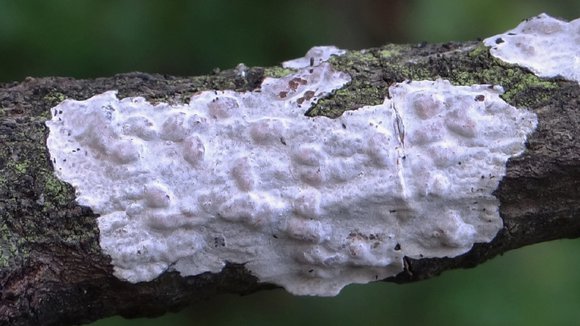Exidiopsis effusa is a real recycler. This fungus is a saprophyte: an organism that lives on and from dead wood. In cold and damp conditions, this microbe causes the phenomenon of hair ice.
Exidiopsis effusa is a real recycler. This fungus is a saprophyte: an organism that lives on and from dead wood. In cold and damp conditions, this microbe causes the phenomenon of hair ice.
Earn your crust
Exidiopsis effusa is a wood recycler. This fungus is a saprophyte: an organism that lives on and from dead wood. Wood is a firm and compact material made up of cellulose, among other things. Only some fungi and bacteria can digest it. E. effusa grows by making a network of hyphae, the mycelium, in wood vessels and wood rays. On the outside of branches and dead wood it can form white to pinkish blue coloured crusts where the fruiting bodies develop.

Exidiopsis effusa on a branch.
Frost bearded fungus
An unusual phenomenon occurs under cold and damp conditions in the forest. In cracks or holes between the bark of dead wood, fuzzy bundles of thin threads of ice develop. More than 100 years ago, scientists already published about this hair ice, also known as beard ice or ice wool. It was striking that a white crusty substance often grew on branches where hair ice was found.
Recent research has shown that there is a biological cause of hair ice. Although the growth of the ice hairs can be explained by a physical process, this process does not take place if the fungus Exidiopsis effusa is absent. The ice hairs are formed when water comes out through rays in the wood. When the outside air is humid and below 0 degrees Celsius, the water freezes and forms an ice lens. A negative pressure arises, which constantly pulls water from the wood. Chemical research showed that there were residues from the breakdown of wood in the ice hairs. These residues from fungal digestion are still very stiff, which results in thin and very long ice hairs.

